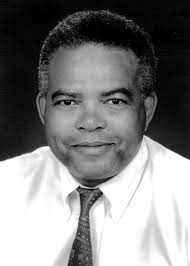Lester Carson Shares Experiences as CJC’s First Black Professor
By Lenore Devore, B.S. Journalism 1984
Lester Carson, at 83, enjoys life as a retiree these days, entertaining one of his four children at his home in Gainesville – the place he’s lived since joining the University of Florida College of Journalism and Communications’ (UFCJC) faculty in 1979 as its first Black professor.

Carson was born in North Carolina, where he received his bachelor’s degree at the University of North Carolina in Chapel Hill. After graduation, he moved to New York City to work for the New York World-Telegram as a general assignment reporter until staffers went on strike in the early 1960s, he said. “Being a GA reporter in New York City was no fun.”
He moved to the Associated Press, where he was a reporter until 1970, when he became associate editor of Black Enterprise Magazine. From there he became editor of Black Sports Magazine before moving his family, which eventually consisted of his wife and four children, to Florida.
He never returned to college to get a master’s degree, but he did accept a fellowship at Columbia University.
He was offered a job to teach at Florida A&M University in Tallahassee, and even though he had never considered it, “I tried and I sort of liked it,” he said.
While there, he attended a conference and met some faculty members from UF. At the time, more women and students of color started entering UFCJC. “We were trying to be more responsive to the makeup of the student body,” said Journalism Professor Emeritus Jean Chance, B.S. Journalism 1960, who taught at the College for 32 years and pushed for diversity on the staff.
Carson was offered a job and accepted. He started as an associate professor in 1979, teaching reporting, editing and Campus Page, a class where journalism students did the reporting, writing, editing, photography and design for a page of college news in the Gainesville Sun.
He never talked about his days reporting in New York, something he regrets. “I’m not sure what college students do these days when they’re reporting. Probably nothing like I did. I covered the streets of Manhattan, riots in Newark and New York City. I wanted to teach more of that when I was teaching, but the reporting courses were mostly writing classes, not reporting courses.”
“I’m not sure what college students do these days when they’re reporting. Probably nothing like I did. I covered the streets of Manhattan, riots in Newark and New York City.”
Today, he would tell students this: “You ought to know jobs are very difficult to come by. If possible, and maybe even necessary, start with a small newspaper. I started with a huge New York City newspaper and I was in over my head most of the time. I think the smaller atmosphere is much more teachable.”
Being a Black man teaching at FAMU, where all but one or two of his students were Black, was easier than teaching at UF. “They showed more respect, whereas I’m teaching a group of white students at UF and there’s a feeling I’m on trial. What’s this guy doing here?”
From time to time, he would revert to his canned editing exercises to introduce students to Black people. “I deliberately included stories about Blacks. Most times, they seemed appreciative of it. One time I had them edit a story on Snoop Dog. They knew as much about Snoop Dog as I did,” he said with a chuckle.
Some of the few Black students in his class thought he was grading them unfairly, he said. “A couple students thought they should have gotten a better grade simply because they and I were black.”
The challenges involving students bothered him more than any incidents with colleagues, he said. Those experiences were varied. “Sometimes good. Sometimes bad. Sometimes there was hostility.
“I had come out of Chapel Hill, where I was the only Black person in my journalism classes,” he said. “I had gotten so I paid as little attention as possible to any kind of negative. Coming to UF, I guess what would have bothered other people didn’t bother me because I was accustomed to it. That does not mean it was all peaches and cream. There were incidents.”
Without getting into specifics, he said, “Some of my colleagues who I thought were my colleagues were maybe not.” He was surprised to find the “good guys” were some of the older journalism professors like Hugh Cunningham and Buddy Davis.
“I was kind of surprised there would be hidden hostility. I would not have expected it.”
“I was kind of surprised there would be hidden hostility. I would not have expected it,” he said.
Chance said she remembers working with Carson and other journalism faculty members in the College’s space at the football stadium, before they moved to Weimer Hall in 1980. Some of the male faculty members would play country music, at times leaving their radios on when they left their offices.
“Les was very offended by country music being ‘white people’ music,” and even though he didn’t say it, there was a feeling it was directed at him, Chance said. If the professors left their doors open, he would go in and turn the radio off. “It didn’t cross my mind that it was anything racial. Les was very diplomatic. We should have been more sensitive than we were.”
He has good memories from CJC, like traveling with Davis, Chance and retired professor Ed Weston in a van to a conference in Atlanta. “Both going and coming, that was a fraternal experience. That was fun.”
From them and others he “learned in a sort of a peculiar way to watch my ass,” Carson said. “Getting tenure, getting the right classes – there’s more competition. And, in fact, in some cases, there’s more cut-throat competition and sometimes you don’t know it until it’s too late.”
Chance said she learned from Carson that she should be a role model to young women as he was to young Black men. “I realized how many Black students – even those not in the Journalism Department because we had a lot of PR kids in classes like reporting – really were drawn to his office. It was a very important lesson for me from Les.”
Carson had a significant impact on both Black and white students: “Les Carson not only taught me how to tell one end of a pica stick – do they still use those? – from the other, he helped guide me through some really uncertain, young-adult years,” said Chuck Tobin, B.S. Journalism 1984 and Hall of Fame 2018, now a partner at D.C.-based law firm Ballard Spahr. “Professor Carson and other faculty like John Griffiths, Ben Patterson and Jean Chance occupied a special neighborhood in Weimer that became both a pastime and refuge. Forming those relationships with wise, kind-hearted grownups had a profound impact on a young me.”
Carson retired in 2005. His wife died years ago, he said, but he spends time with his four children. “At the moment I am entertaining my visiting daughter from Chicago.”
Category: Digest Only, Profiles
Tagged: First Black Professor Lester Carson
Subscribe to our News Digest


